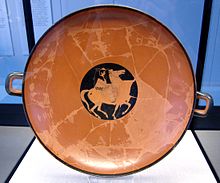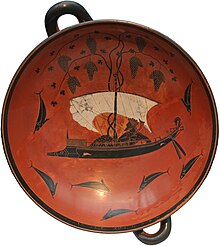Intentional Red
As Intentional Red , commonly known by the English terms Intentional Red Glaze / Gloss , Coral-red gloss and sealing-wax pottery , rare under the German term Coral reason is, in the classical archeology a special technique of Black figure and red-figure vase painting called.

The coral-red bottom was discovered during the 530s BC. Developed in Athens . At this time a great dynamic reached the potters and vase painters in Athens. They experimented with ever new styles and techniques: the Six's technique , the white-ground vase painting , the relief line and finally the red-figure style. Personalities such as the potters Nikosthenes and Kachrylion or the potter painter Exekias influenced the development both artistically and economically.
Exekias , probably the most important and innovative of the black-figure vase painters, is considered to be the inventor of the style . His Dionysus bowl from around the year 535 BC. BC, which was signed by Exekias as a potter, is considered to be the oldest work of the style and one of the most famous ancient Greek vases at all. The following pieces also primarily contain bowls , as well as phials and volute craters . Some of the most famous vase painters of their time, such as Sotades , Psiax , Scythes , the Berlin painter , the Cleophrades painter and Euphronios , decorated vases in the style. Among the potters, besides the names mentioned, Hegesiboulos is also known as the creator. Some painters such as Piax and Exekias added red and white color to their pictures, as was not unusual in the black-figure style. It is believed that the style was hardly used in any significant way for ten years. The latest works are dated around 100 years after the style was invented.
The English term intentional red alludes to the fact that, unlike incorrect fires - so-called accidental red ceramic, i.e. accidental red - the red color was planned. The addition coral red also refers to the red-figure style from which it is differentiated. The figures of the red-figure style are orange, unlike the background of the coral-red background. Sometimes false fires also appear like vases of the coral-red shape.
literature
- Beth Cohen : Coral-red gloss. Potters, Painters, and Painter-Potters. In: Beth Cohen (Ed.): The colors of clay. Special techniques in Athenian vases. J. Paul Getty Museum, Los Angeles CA 2006, ISBN 0-89236-571-4 , pp. 44-53.
- Zvi Goffer: Archaeological Chemistry (= Chemical Analysis. Vol. 170). 2nd Edition. Wiley-Interscience, Hoboken NJ 2007, ISBN 978-0-471-25288-7 , p. 254.
- Kenneth Lapatin (Ed.): Papers on Special technicques in Athenian Vases. Proceedings of a symposium held in connection with the exhibition “The colors of clay. Special techniques in Athenian vases ", at the Getty Villa, June 15-17, 2006. J. Paul Getty Museum, Los Angeles CA 2008, ISBN 978-0-89236-901-0 , p. 121.
Web links
- To the exhibition The colors of clay (English)
